4 Rules of Gun Safety: All You Need to Know [2024]
 Bryan Hill / January 20 2024
Bryan Hill / January 20 2024
CDC.gov reports that in 2017, 486 people lost their lives and 20,488 people were injured. How? Not through malice, but negligent discharge (ND) of a firearm.
The good news? There are fewer of these accidents as the years go by. Why? Better training and education.
The risk of accidental gun death each year is now 1 or 2 in a million, depending on age:
[2]
Each tragedy is preventable. They only happen by breaking one or more of the four rules of gun safety.
Let's dig in and, and learn why they matter through shocking real-world examples.
On This Page:
- Keep Your Trigger Finger Safe until You Choose to Fire
- Point your Gun in a Safe Direction
- ID Your Target, Obstructions, and Backstop
- Always Treat Guns as if They're Loaded
- Conclusion
- References
1. Keep Your Trigger Finger Safe until You Choose to Fire
Around 6.2% of accidental deaths from firearms are from:
[2]
-
Someone falling with a gun in hand.
-
Grabbing for a falling gun.
-
Some other startle response.
Modern firearms only fire when the trigger is pulled.
People often react to a ND by saying, "the gun just went off".
But it's usually that person's moral failure to own up, not a mechanical failure of the gun.
How do NDs happen? Anytime you get startled, the natural response is to clench both your hands.
This guy got a burning hot brass casing down his back. Look what happens as he reaches for it:
The guy behind him nearly got blown away. How do we prevent this?
Your trigger finger is safe when it's resting as high up on the gun as possible.
This is known as maintaining trigger discipline.
On a pistol, rest it on the slide.
As your finger gets closer to the trigger guard, the more likely it will find the trigger as it clenches shut.
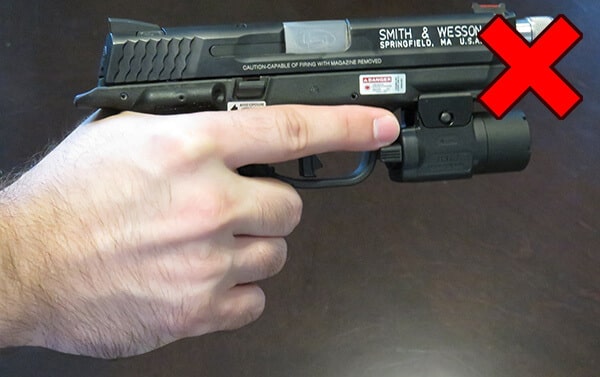
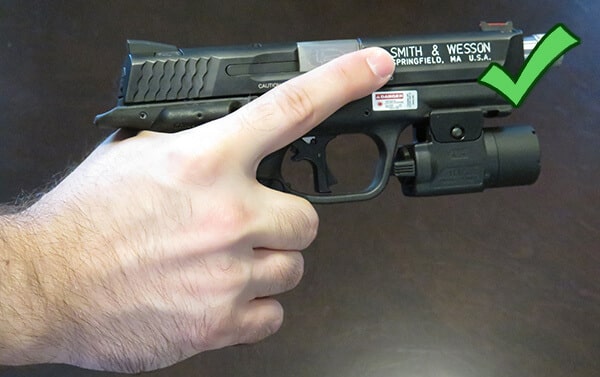
So until you choose to fire, keep your trigger finger safe.
What's safe? It's high enough to not slip onto the trigger no matter how hard you clench.
When in doubt, keep it up on the slide.
Otherwise you can end up like this guy:
2. Point your Gun in a Safe Direction
Around 30.7% of accidental deaths from firearms are from someone:
[2]
-
Thinking the gun was unloaded.
-
Cleaning or loading the gun.
They got lax with where it was pointed, pulled the trigger, and...bang.
Here's an example of an accidental discharge, but no one got hurt. How?
He kept his pistol pointed downrange the whole time. He maintained muzzle discipline.
The muzzle is where the bullets come out, so point it at something safe.
What's safe? Anything that stops bullets without hurting people.
If you're at a shooting range and on the firing line,and have your pistol pointed downrange,it should be safe.
Why do we need this rule? No one has perfect trigger discipline all the time. We're human.
And as we can see in the above video, in rare cases the gun itself can cause a ND.
When that happens, it's usually due to shoddy custom work.
The tricky part is having good muzzle discipline during weapon handling:
-
Picking up or drawing the pistol.
-
Reloading.
-
Clearing jams.
-
Holstering.
-
Moving around while holding a gun.
Some real-world examples of people failing to follow this rule:
3. Always ID Your Target, Obstructions, and Backstop
Around 13.8% of accidental deaths from firearms are from failing to ID the target while hunting.
[2]
There's another cause: Have you or anyone you know ever come home late at night? Do you want this to be you?
Though rare, tragedies like in the above video occur every year. They're a fatal failure to follow this rule.
Always ID your target before you shoot.
If it's too dark for that, ID them with a flashlight or a weapon-mounted light.
Obstructions are things between you and your target, whether you hit or miss your target.
Think of bystanders that might move across the line of fire.
The backstop is whatever ultimately stops your bullets. If you miss your target, will your bullets hurt a bystander? Your bullets could go through the target. What happens then?
Here's a bad example:
And a good one:
Just a side-step or two can make all the difference in safe shooting.
4. Always Treat Guns as if They're Loaded
Around 45.5% of accidental deaths from firearms are from:
-
Playing with a gun.
-
Thinking the gun was unloaded.
And in around 22.7% of accidental deaths, the shooter was suspected to be drunk, with the rate varying by age bracket.
People age 20-29 were most at risk of drunken gun deaths, at 46.8%.
[2]
Listen to what this guy says at the start of the video. How many safety rules did he break? Which did he break first?
When we grow complacent, we begin to break the other rules. Then it's just a matter of time until we cause an ND.
Never assume a firearm is unloaded. Instead, unload the pistol and verify.
The firearm is clear if you lock the the slide back and:
You can see all the way through the magazine well to the ground below.
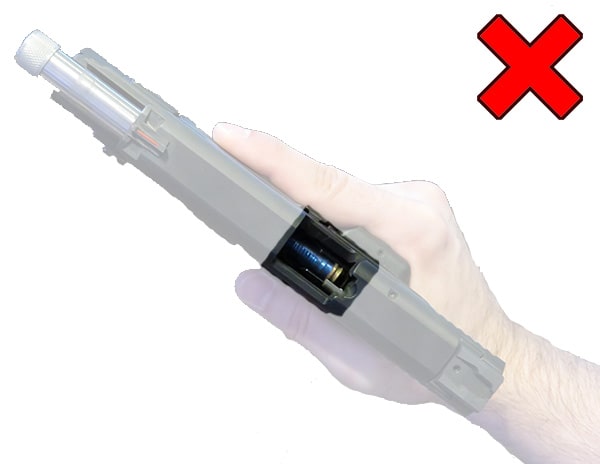
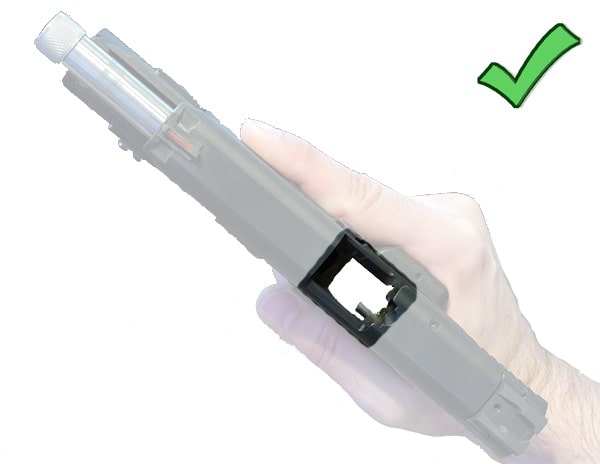
The ammo pictured is a snap cap, an inert dummy round for practice.
And there is no ammunition lodged in the barrel.
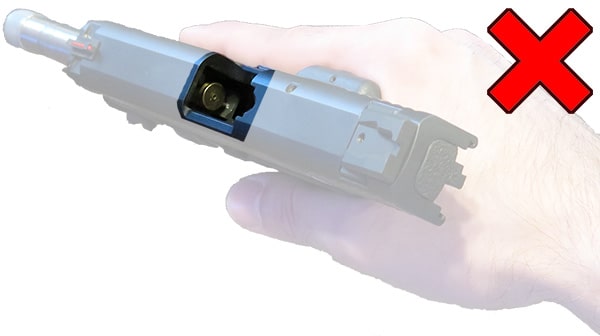

The ammo pictured is a snap cap, an inert dummy round for practice.
Even after you've verified a firearm is unloaded, maintain trigger and muzzle discipline.
ID your target and backstop.
Why? It builds safe habits. The creep of complacency can be costly or fatal.
Conclusion
- Nearly all accidental harm from firearms comes from failing the rules of gun safety.
- Responsible gun owners obey firearms safety rules.
Related Articles
Feedback
Are you happy with this page?
References
-
Jacksonville Officer Stops Threat To Disabled Veteran (2020)
-
Unintentional firearm deaths in the United States 2005–2015 (2019)
-
Man banned from gun range after gun play (2018)
-
Negligent Discharge Sympathetic response (2018)
-
Officer's Neglect of Rules of Firearm Safety, Bad Marksmanship Injure Child | Active Self Protection (2018)
-
Two Stark Reminders of the Importance of Firearms Safety | Active Self Protection (2017)
-
How to accidentally discharge your pistol properly. (2016)
-
Surveillance video shows accidental shooting at gun range (2014)
-
14 year old shot and killed by stepfather (2013)
-
Man falls over whilst holding pistol and fires twice haha! fail! (2011)
-
DEA Agent Shoots Himself in the Foot (2006)